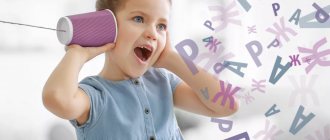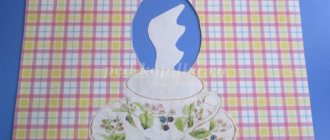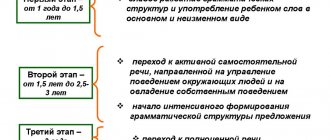Rhetorical exercises are a set of techniques and techniques that are intended for the development of oral speech in children of senior preschool age, as well as students of general education institutions. During classes on the development of the speech apparatus, the child’s oratory skills are trained, communication abilities are formed, and motor skills of the hands and facial muscles are improved.
Rhetoric and exercises for speech development are useful for preschool children.
Rhetoric exercises are performed under the guidance of a teacher, educator or speech therapist. The methods and techniques for conducting classes are selected by a specialist on an individual basis.
Methods of speech development in preschool children
Rhetorical exercises for the development of oral speech in children involve the use of several pedagogical techniques, which are described in detail in the table below:
| Name of the technique | Description of the pedagogical process |
| Assessment of lesson results | Before starting training on the development of rhetorical skills, the teacher prepares special sheets for assessing knowledge. After the child completes a certain exercise, the teacher fills out an evaluation sheet, indicating the clarity and content of the student’s speech. This information is taken into account during subsequent sessions to monitor the child's level of progress. |
| Vocabulary expansion | Most of the difficulties in acquiring public speaking abilities are associated with poor vocabulary. In conjunction with performing classical exercises, it is necessary to use a dictionary. According to the teacher’s instructions, the child learns from 3 to 7 new words every day, depending on his intellectual abilities. |
| Retelling of the material presented | This technique allows you to learn the correct and consistent presentation of thoughts. First, the teacher reads a short passage of text, and then the children take turns telling in their own words what they heard. |
| Presentation | The rhetorical technique in the form of a presentation makes it possible to develop oratory skills and increase the child’s level of communication skills. The essence of this technique is that children take turns describing household items that were provided by the teacher. Each child tries to present the maximum amount of information about a given object. |
Methods for performing rhetorical exercises can be used in combination, or only one of the above-described techniques for developing oratorical abilities is used. At the same time, the number of people in the group, their age and level of intellectual development are taken into account.
How to develop oratory skills in a child
Speaking in front of an audience is a difficult task for an adult, let alone children. But you can teach your child this art from an early age using simple tips:
Consider temperament. Sanguine and choleric people are not afraid to be the center of attention, which cannot be said about phlegmatic and melancholic people. You need to determine your child’s temperament as early as possible and help him, cheer him up before the performance.
- Create interest. If a performance does not bring happiness and pleasure to the child, there is no need to force him.
- Rehearsals. You can ask the child to read a passage from the text with feeling, and the parent will be a spectator at this time. Then change. This will allow the young speaker to experience different roles.
- Games. To relieve stress, you can play calm games, puppet theater, and role-playing games.
- Improvisation. Developing imagination is useful at any age. Writing a story together and reading it at family dinner is a great idea!
- Parent as an example. After reading a short excerpt with inspiration, the parent will show how you can speak and not be afraid of your audience.
- Stay alert. When a child feels the parent's interest, he tries even harder. Not paying attention to performances is a sure way to undermine your confidence.
- Selection and reading. It is important to let your child choose a piece to perform on their own.
- Recording of speeches. This will allow you to have fun and see from the outside what both a child and an adult look like.
Video lesson - teaching public speaking (basic exercises)
Exercises for young children
Exercises for older preschool children
Rhetoric (exercises for the development of oral speech train the centers of the brain) has different levels of complexity. For children of senior preschool age, classes are held, the content of which corresponds to the amount of knowledge of each child.
Exercise “Story on a free topic”
To perform this collective exercise, it is enough for a group of children to be formed in the amount of 5 to 10 people. The average duration of a lesson is from 25 to 50 minutes. This is the period of time that will allow you to achieve maximum productivity in the educational process, as well as maintain a sufficient level of interest in children. Each child is given about 5 minutes to perform.
Goals and objectives
The main goal and objective of the exercise is to effectively form a culture of child’s speech behavior.
Equipment and materials
To conduct this lesson you will need the following equipment and materials:
- chairs to seat all group members, creating a target audience for the speaker;
- a clock with a timer to record the duration of each child’s performance;
- a chair and desk for the teacher, who sits away from the children;
- an improvised stage on which each child will appear during their performance.
After completing the preparatory activities, you can begin this exercise.
Methodology used
During this exercise, it is recommended to use a technique for assessing the progress of each child. To do this, you will need to prepare a checklist in advance, which will display the achievements of all students.
Introduction
At this stage, the teacher invites the children to take turns going on stage and performing an oral story on a given topic. The teacher focuses on the fact that the narration should be expressive, interesting, but at the same time as concise as possible, since each speaker has only 5 minutes.
Progress of the lesson
Completing the exercise “Story on a free topic” involves following the following algorithm of actions:
- The teacher invites the child onto an improvised stage in front of an audience of other children.
- Then the teacher asks the student to tell a story about a particular event. For example, a story on the topic: “How I visited my grandmother,” “Fishing trip with my father,” “My pet.” The topic for the story is chosen to be free and accessible to a child of the appropriate age.
- The child talks about a given topic for 5 minutes.
- After this, the teacher, together with the children, thanks the speaker, and then invites the next child to speak.
Children who are lost, embarrassed or have difficulty telling a story during a speech need to be encouraged and given confidence in their actions.
Knowledge control
At the end of the training, the teacher fills out a checklist in which he evaluates the speaking abilities of each child.
The following criteria are taken into account:
- clarity of speech;
- expressiveness;
- richness of vocabulary;
- content of the speech;
- brevity.
To carry out the assessment, a scale of 5 or 10 points is used. At the same time, the results of knowledge control are not disclosed to the children, but are used only by the teacher to further improve the rhetorical skills of each child.
The final stage
At the final stage of this lesson, the children thank each other for the interesting stories they heard during this exercise.
Exercise “Characteristics of an object”
Characterizing an object is an exercise that requires forming a group of 5 children. The average duration of a performance for 1 child is 10 minutes.
In total, the lesson lasts 50 minutes. working hours.
Goals and objectives
The purpose of this lesson is to form in the child the initial inclinations for oratory skills, to teach him the correct and consistent presentation of thoughts.
Equipment and materials
To conduct this lesson you will need to use the following materials:
- ball;
- Toothbrush;
- pencil;
- paper;
- plasticine.
All children of primary preschool age are familiar with these objects and can also describe their characteristics and purpose.
Methods used
During this lesson, methods are used in the form of assessing the child’s abilities using a checklist, and also use presentation techniques.
Introduction
At the preparatory stage, the teacher places the above items on the table in front of the children. After this, the teacher tells the children that they need to take turns standing up, coming forward and describing one of these things.
Progress of the lesson
An exercise to develop rhetorical abilities “Characteristics of the subject” is performed as follows:
- The teacher invites the child to an impromptu stage.
- The speaker receives one of the items described in the section above.
- According to the teacher’s instructions, the child spends 10 minutes. must tell the maximum amount of information about the thing given to him. The characteristics of the object and its intended purpose are fulfilled.
- After the specified period of time has passed, the child sits down, and the next group member is invited to perform.
During this lesson, the teacher can ask the child leading questions that simplify the storytelling process.
Knowledge control
Based on the results of the training, the teacher assigns grades to all participants in a checklist.
The final stage
At the final stage of the lesson, the teacher thanks the children for participating in the training, says that they tried very hard, and their stories were interesting.
How do we teach?
Of course, we teach in practice. After all, there is no other way to master oratory.
No long lectures, our rhetoric is practice.
So our students do various practical exercises. They speak extemporaneously, retell parables, read stories, and make up stories.
Of course, watch this video:
Rhetoric is taught through games and practical exercises .
- It won't be boring, but it will be interesting.
And it won’t be difficult, but it will be easy and fun.
Why do children need oratory?
First of all, public speaking will be useful in school. As a result, schoolchildren will answer better at the blackboard in class, write reports and essays.
Further, rhetoric will improve communication with friends. As a result, children will learn to speak freely and uninhibitedly. They will also learn not to be shy, to be able to take the floor and defend an opinion, to attract attention and lead.
Oratory skills will also help in communicating with adults . Agree, children do not always succeed in this. Therefore, children learn to convey their thoughts to parents, relatives or teachers.
Video. Fable The Lion and the Mouse performed by a young speaker
Online public speaking courses for children
- Public speaking training is designed specifically for young speakers.
- Online public speaking courses take place at a convenient time and you can study anywhere in the world .
- Minimum theory – maximum practice.
- The level of initial training does not matter much.
- You will get noticeable results after the first lesson with a trainer.
- We try to approach each child's education individually .
Rhetoric. Young speaker.
Exercises for elementary school children
Rhetoric (exercises for the development of oral speech help improve a child’s communication skills) is mastered only if the principle of regular training is observed. For primary school children, classes with a higher level of difficulty are used.
Exercise for 1st grade students “Alphabet”
This exercise can be performed by an unlimited number of children, 1st grade students. The total duration of the lesson is from 20 to 30 minutes. The training itself is collective.
Goals and objectives
The main goal of this lesson is to develop children's associative and creative speech, as well as general rhetoric skills.
Equipment and materials
To complete this exercise, you will need a school board on which the initial information will be written.
Methods used
During this lesson, rhetorical techniques are used in the form of working with a dictionary and evaluating the results of the training.
Introduction
1st grade students sit at their desks. The teacher writes various letters of the alphabet on the board, for which each group member will have to come up with 1 word.
Progress of the lesson
The rhetorical exercise “Alphabet” is performed in compliance with the following algorithm of actions:
- The teacher writes various letters of the alphabet on the board with the exception of “ы, ъ, ь”.
- After this, the teacher asks the children to come up with words starting with the letters indicated on the board.
- Students perform this exercise one by one, raising their hand, or the teacher himself decides in what order the children will answer.
To complicate the current task, you can try to create a short story of several sentences in which all words begin with the same letter.
Knowledge control
At the end of the lesson, the teacher fills out a checklist, assessing the rhetorical abilities of each child. The success of group members is determined by a 5 or 10 point system at the discretion of the teacher.
The final stage
The final stage of the training to develop rhetoric skills is a dialogue between children and the teacher, during which the teacher asks the students the following questions:
- Did they cope with this task easily?
- What did you like about this exercise?
- What details should be added to the next lesson?
- Have new words been learned?
Children who have discovered new words pronounce them out loud. The teacher can ask clarifying questions about their meaning.
Exercise for 2nd grade students “Drawing in the air”
To perform this exercise, there must be 10 children in the group. The average speaking time for 1 person is 5 minutes.
The approximate duration of the lesson is 50-60 minutes.
Goals and objectives
The purpose of this lesson is to develop the child’s speech behavior skills, as well as to develop his hand motor skills and improve coordination of movements during a conversation.
Equipment and materials
To complete this lesson you will need the following items:
- ruler;
- pencil case;
- notebook;
- book;
- briefcase;
- pen;
- ball;
- plate;
- toy car;
- paints.
Most 2nd grade students are familiar with the intended purpose of these things and can describe their properties and external characteristics. If necessary, the teacher gives hints and asks the child leading questions.
Methods used
During the “Drawing in the Air” lesson, a technique is used to assess the level of the child’s oratory abilities, and they also use the presentation technique of the described object.
Introduction
Before the start of the lesson, the teacher lays out the above items. Then he explains to the group members that they will need to take turns going to the board, taking one of the things and telling as much information as possible about it.
Upon completion of the story, using your fingers, you need to draw the described object in the air.
Progress of the lesson
The rhetorical exercise “Drawing in the Air” is performed as follows:
- The teacher invites the child to the board.
- The student takes any of the things laid out.
- The child gives an external description of the object, indicates its intended purpose, main functions, and value.
- Upon completion of the story, the student tries to draw in the air the object that he told the teacher and other group members about.
After completing the presentation, the teacher invites the next student to the board, who performs similar actions. The group maintains an informal atmosphere. Children should remain liberated, predisposed to the manifestation of creative and communicative abilities.
Knowledge control
Knowledge control is carried out by grading a checklist.
The final stage
At the final stage, all group members and the teacher thank each other for their informative stories.
Exercise for 3rd grade students “Retelling a heard text”
During this lesson, you can work with an unlimited number of children, but maximum productivity of the training is ensured if the group consists of 10 people.
The average duration of this exercise is 35 minutes.
Goals and objectives
The purpose of this lesson is to develop stable speech skills, increase the level of communication and creativity.
Equipment and materials
To complete this exercise, the teacher will need a literary work intended for children of the appropriate age.
Methods used
During this lesson, the following types of techniques are used:
- expansion of vocabulary;
- evaluation of final results using a checklist;
- retelling of the material presented.
Through the simultaneous use of several techniques, the effect of complex development of rhetorical abilities is achieved.
Introduction
The teacher explains to the children that he will read a certain passage of text that will need to be retold.
Progress of the lesson
This exercise is performed in compliance with the following algorithm of actions:
- The teacher reads to the children a short excerpt from a work of art, the average length of which is 500-700 words.
- The teacher asks each child to retell the text they heard.
- Children take turns telling the material they read.
Depending on the size of the group, a separate passage of text may be read to each student. This approach will complicate the task.
Knowledge control
Evaluation of the results of the exercise is carried out using a checklist according to the method described in the sections above.
The final stage
At the final stage of the lesson, the teacher asks the children what they liked and remembered most during this training.
Exercise for 4th grade children “Complete the story”
Rhetoric (exercises for the development of oral speech improve a child’s diction) is the science of public speaking skills. An activity called “Complete the story” is performed with direct communicative interaction between group members. The average training duration is 30-35 minutes. The number of participants is not limited.
Goals and objectives
The purpose of this lesson is to teach children active communication, increase their vocabulary and improve rhetorical abilities.
Equipment and materials
During the “Complete the Story” exercise, a red flag or any object is used that will symbolize the passing of the baton from one participant to the next.
Methods used
In this case, methods for expanding vocabulary and assessing current achievements using a checklist are used.
Introduction
The introductory part of this lesson begins with the teacher explaining to the children the principle of conducting rhetorical training.
Participants must enter into a discussion with each other, continuing the proposal they started.
Progress of the lesson
The “Complete the story” exercise is performed in compliance with the following algorithm of actions:
- The child takes a red flag, goes to the board, and then recites 1 sentence of an impromptu story on a free topic. For example, “I came home today, and there was a big shaggy dog sitting in the living room.”
- This participant passes the flag in the form of a relay to the next child, who within 2 minutes. must continue the story started, coming up with a logical conclusion to this story.
- After this, the child pronounces a new introductory sentence and passes the baton to the next participant.
The exercise takes place in an unobtrusive environment, reminiscent of an interactive game.
Knowledge control
The teacher observes what is happening, assessing the children's rhetorical abilities on a checklist.
The final stage
At the final stage of the “Complete the story” lesson, the teacher thanks all the children for doing an excellent job with the exercise, and also asks them the following questions:
- Did you like the topic of the exercise?
- Who would like to complicate the lesson with additional tasks?
- Which story was most memorable to you?
Rhetoric (exercises for the development of oral speech are useful for children of all age groups) includes a set of activities that can improve communication skills and get rid of feelings of timidity and embarrassment when communicating with other people.
Rhetorical exercises for the development of oral speech are interactive classes conducted by a teacher with extensive practical experience or a speech therapist. Trainings to improve public speaking abilities are prescribed to children of senior preschool age and primary school students.
When performing rhetoric exercises, they use methods to assess the knowledge of each group member, use the technique of retelling the material read, and conduct presentations of previously prepared items. Children attending these classes are distinguished by good diction, sociability, clarity of speech and a rich vocabulary.
School of rhetoric for children online
Watch this video
Read more
- How we teach
- Price
- Trainer
- The same online training, but for adults
- Sign up
Program
Public speaking coach for children Victoria Sulay
We teach children public speaking online
Our students can:
- speak at the board and on stage;
- tell poems, parables, legends and answer in class;
- write essays, abstracts, reports...
Our courses develop in children not only:
- self confidence;
- lexicon;
- ability to defend a point of view
But there are also other important public speaking skills.
We train schoolchildren from 10 to 16 years old . At the same time, children enjoy teaching because we have interesting tasks.
The future speaker does exercises in front of the monitor.









